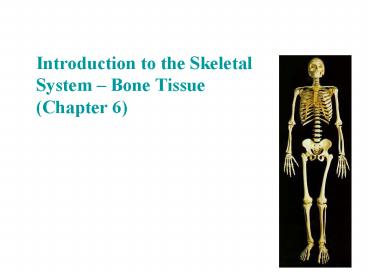Introduction to the Skeletal System - PowerPoint PPT Presentation
1 / 11
Title:
Introduction to the Skeletal System
Description:
Introduction to the Skeletal System Bone Tissue (Chapter 6) In addition to bones, the skeletal system includes cartilage, tendons (connect bones to muscles ... – PowerPoint PPT presentation
Number of Views:338
Avg rating:3.0/5.0
Title: Introduction to the Skeletal System
1
- Introduction to the Skeletal System Bone
Tissue (Chapter 6)
2
In addition to bones, the skeletal system
includes cartilage, tendons (connect bones to
muscles), ligaments (connect bones to bones)
3
Functions of the Skeletal System
- SUPPORT
- PROTECTION
- MOVEMENT
- STORAGE OF MINERALS
- BLOOD CELL FORMATION
4
Classification of Bones
5
Features of a Long Bone
- Epiphysis (head) - end of the bone
- Diaphysis (shaft) - surrounds the marrow cavity
- Epiphyseal plate - layer of cartilage allowing
bone to grow in length when bone stops growing,
cartilage is replaced by bone - epiphyseal line - Articular Cartilage - reduces friction, absorbs
shock, and allows for smooth movement
6
(No Transcript)
7
Bone Histology
- Connective tissue
- Dense matrix primarily made of collagen and
hydroxyapatite - Ca10(PO4)6(OH)2 - Matrix contains bone cells
- Osteogenic cells undergo cell division and
become osteoblasts - Osteoblasts form new bone
- Osteocytes mature osteoblasts maintain
bone - Osteoclasts break bone down
8
Osteoblasts, Osteocytes, Osteoclasts
9
Types of Bone Tissue
- Spongy
- Irregular lattice of thin columns trabeculae
- Trabeculae reduce weight, protect red bone marrow
- Trabeculae are oriented along lines of stress
- Compact
- very dense strong
- most of the bone mass in the body
10
More about the Compact Bone
Osteon basic functioning unit of compact
bone Central canal contains blood vessels
nerve Lacunae spaces that house osteocytes
11
Osteon (Haversian System)































